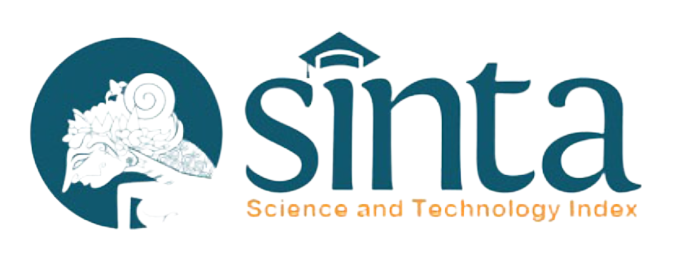Klasifikasi Penyakit Alzheimer Dari Scan Mri Otak Menggunakan Convnext
DOI:
https://doi.org/10.25126/jtiik.2024118117Abstrak
Penyakit Alzheimer adalah gangguan neurodegeneratif yang menyebabkan penurunan fungsi kognitif yang signifikan. Penanganan penyakit ini dapat dilakukan melalui deteksi dini untuk meningkatkan kualitas kehidupan pasien melalui perawatan medis yang efisien dan tepat waktu. Teknologi machine learning dan neural network dapat mendukung deteksi dini melalui penggunaan model ConvNeXt yang telah dilatih dengan metode transfer learning menggunakan bobot awal dari ImageNet, dan di-fine-tune untuk mengklasifikasikan empat tingkat keparahan Alzheimer berdasarkan hasil pemindaian MRI otak, yaitu Mild Demented, Moderate Demented, Non Demented, dan Very Mild Demented. Penelitian ini akan menghasilkan model h5 dengan akurasi yang lebih baik daripada model lain sehingga dapat di-deploy pada aplikasi atau website untuk membantu deteksi dini klasifikasi tingkat keparahan Alzheimer.
Abstract
A Alzheimer's disease is a neurodegenerative disorder that causes significant cognitive decline. Early detection is crucial for managing this disease to improve patients' quality of life through efficient and timely medical care. Machine learning and neural network technology can support early detection through the use of the ConvNeXt model, which has been trained using transfer learning with initial weights from ImageNet and fine-tuned to classify four stages of Alzheimer's severity based on brain MRI scans: Non Demented, Very Mild Demented, Mild Demented, and Moderate Demented. This research will produce an h5 model with better accuracy than other models, enabling it to be deployed in applications or websites to assist in the early detection and classification of Alzheimer's severity.
Downloads
Referensi
ADAM, S. P., ALEXANDROPOULOS, S. A. N., PARDALOS, P. M., & VRAHATIS, M. N. 2019. No free lunch theorem: A review. Springer Optimization and Its Applications, 145, 57–82. https://doi.org/10.1007/978-3-030-12767-1_5/COVER
ADITYA SINGH. 2022, February. ConvNext: The Return Of Convolution Networks. https://medium.com/augmented-startups/convnext-the-return-of-convolution-networks-e70cbe8dabcc
Alzheimer’s Indonesia. 2019. Statistik tentang Demensia - Alzheimer Indonesia. Last Accessed: 14 September 2023. https://alzi.or.id/statistik-tentang-demensia/
FERRARI, C., & SORBI, S. 2021. The Complexity Of Alzheimer’s Disease: An Evolving Puzzle. Physiological Reviews, 101(3), 1047–1081.
https://doi.org/10.1152/PHYSREV.00015.2020/ASSET/IMAGES/LARGE/PHYSREV.00015.2020_F009.JPEG
GREENBLAT, C. 2023. Dementia. Last Accessed: 14 September, 2023. https://www.who.int/news-room/fact-sheets/detail/dementia
HIPPIUS, H., & NEUNDÖRFER, G. 2022. The discovery of Alzheimer’s disease. Https://Doi.Org/10.31887/DCNS.2003.5.1/Hhippius, 5(1), 101–108. https://doi.org/10.31887/DCNS.2003.5.1/HHIPPIUS
LI, Z., GU, T., LI, B., XU, W., HE, X., & HUI, X. 2022. ConvNeXt-Based Fine-Grained Image Classification and Bilinear Attention Mechanism Model. Applied Sciences (Switzerland), 12(18). https://doi.org/10.3390/app12189016
LIU, Z., MAO, H., WU, C. Y., FEICHTENHOFER, C., DARRELL, T., & XIE, S. 2022. A ConvNet for the 2020s. Proceedings of the IEEE Computer Society Conference on Computer Vision and Pattern Recognition, 2022-June, 11966–11976. https://doi.org/10.1109/CVPR52688.2022.01167
OH, K., CHUNG, Y. C., KIM, K. W., KIM, W. S., & OH, I. S. 2019. Classification and Visualization of Alzheimer’s Disease using Volumetric Convolutional Neural Network and Transfer Learning.
Scientific Reports 2019 9:1, 9(1), 1–16. https://doi.org/10.1038/s41598-019-54548-6
SCHACHTER, A. S., & DAVIS, K. L. 2022. Alzheimer’s disease. Https://Doi.Org/10.31887/DCNS.2000.2.2/Asschachter, 2(2), 91–100. https://doi.org/10.31887/DCNS.2000.2.2/ASSCHACHTER
YAMASHITA, R., NISHIO, M., DO, R. K. G., & TOGASHI, K. 2018. Convolutional neural networks: an overview and application in radiology. Insights into Imaging, 9(4), 611–629. https://doi.org/10.1007/S13244-018-0639-9/FIGURES/15
OKTAVIA PUTRI, O, N. 2020. Implementasi Metode CNN Dalam Klasifikasi Gambar Jamur Pada Analisis Image Processing.
AZMI, K., DEFIT, S., SUMIJAN. 2023. implementasi Convolutional Neural Network (CNN) Untuk Klasifikasi Batik Tanah Liat Sumatera Barat. https://ejurnal.sttdumai.ac.id/index.php/unitek/article/download/504/350
MAGDALENA, R., SAIDAH, S., PRATIWI, N, K, C, P., PUTRA, A, T. 2021. Klasifikasi Tutupan Lahan Melalui Citra Satelit SPOT-6 dengan Metode Convolutional Neural Network (CNN). https://jurnal.untan.ac.id/index.php/jepin/article/download/48195/75676591380
ZHANG, Y., XU, A., LAN, D., ZHANG, X., YIN, J., & GOH, H. H. 2023. ConvNeXt-based anchor-free object detection model for infrared image of power equipment. Energy Reports, 9, 1121–1132. https://doi.org/10.1016/j.egyr.2023.04.145
KUNDARAM, S., & PATHAK, K., 2020. Deep Learning-Based Alzheimer Disease Detection. Lecture Notes in Electrical Engineering. https://doi.org/10.1007/978-981-15-5546-6_50
HAMMOND, T., XING, X., WANG, C., MA, D., NHO, K., CRANE, P., ELAHI, F., ZIEGLER, D., LIANG, G., CHENG, Q., YANCKELLO, L., JACOBS, N., & LIN, A., 2020. β-amyloid and tau drive early Alzheimer’s disease decline while glucose hypometabolism drives late decline. Communications Biology, 3. https://doi.org/10.1038/s42003-020-1079-x.
XU, L., LIANG, G., LIAO, C., CHEN, G., & CHANG, C., 2019. k-Skip-n-Gram-RF: A Random Forest Based Method for Alzheimer's Disease Protein Identification. Frontiers in Genetics, 10. https://doi.org/10.3389/fgene.2019.00033.
MENG, X., WEI, Q., MENG, L., LIU, J., WU, Y., & LIU, W., 2022. Feature Fusion and Detection in Alzheimer’s Disease Using a Novel Genetic Multi-Kernel SVM Based on MRI Imaging and Gene Data. Genes, 13. https://doi.org/10.3390/genes13050837.
SUN, Z., QIAO, Y., LELIEVELDT, B., STARING, M., & INITIATIVE, A., 2018. Integrating spatial-anatomical regularization and structure sparsity into SVM: Improving interpretation of Alzheimer's disease classification. NeuroImage, 178, pp. 445-460. https://doi.org/10.1016/j.neuroimage.2018.05.05.
NAWAZ, A., ANWAR, S., LIAQAT, R., IQBAL, J., BAGCI, U., & MAJID, M., 2020. Deep Convolutional Neural Network based Classification of Alzheimer's Disease using MRI Data. 2020 IEEE 23rd International Multitopic Conference (INMIC), pp. 1-6. https://doi.org/10.1109/INMIC50486.2020.9318172.
CHEN, S., OGAWA, Y., & SEKIMOTO, Y. 2023. Large-scale individual building extraction from open-source satellite imagery via super-resolution-based instance segmentation approach. ISPRS Journal of Photogrammetry and Remote Sensing, 195, 129–152. https://doi.org/10.1016/j.isprsjprs.2022.11.006
Unduhan
Diterbitkan
Terbitan
Bagian
Lisensi
Hak Cipta (c) 2024 Jurnal Teknologi Informasi dan Ilmu Komputer

Artikel ini berlisensiCreative Commons Attribution-ShareAlike 4.0 International License.

Artikel ini berlisensi Creative Common Attribution-ShareAlike 4.0 International (CC BY-SA 4.0)
Penulis yang menerbitkan di jurnal ini menyetujui ketentuan berikut:
- Penulis menyimpan hak cipta dan memberikan jurnal hak penerbitan pertama naskah secara simultan dengan lisensi di bawah Creative Common Attribution-ShareAlike 4.0 International (CC BY-SA 4.0) yang mengizinkan orang lain untuk berbagi pekerjaan dengan sebuah pernyataan kepenulisan pekerjaan dan penerbitan awal di jurnal ini.
- Penulis bisa memasukkan ke dalam penyusunan kontraktual tambahan terpisah untuk distribusi non ekslusif versi kaya terbitan jurnal (contoh: mempostingnya ke repositori institusional atau menerbitkannya dalam sebuah buku), dengan pengakuan penerbitan awalnya di jurnal ini.
- Penulis diizinkan dan didorong untuk mem-posting karya mereka online (contoh: di repositori institusional atau di website mereka) sebelum dan selama proses penyerahan, karena dapat mengarahkan ke pertukaran produktif, seperti halnya sitiran yang lebih awal dan lebih hebat dari karya yang diterbitkan. (Lihat Efek Akses Terbuka).












